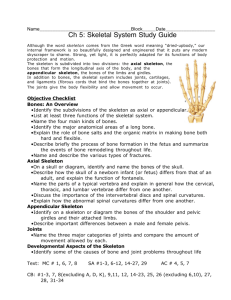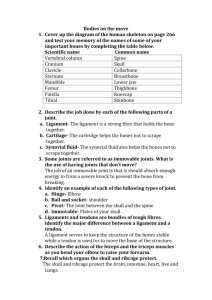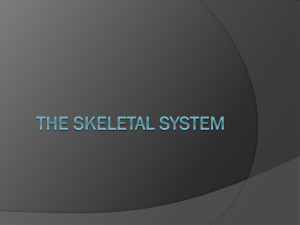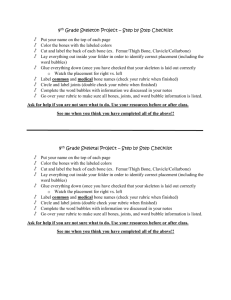Bones and Joints 1
advertisement
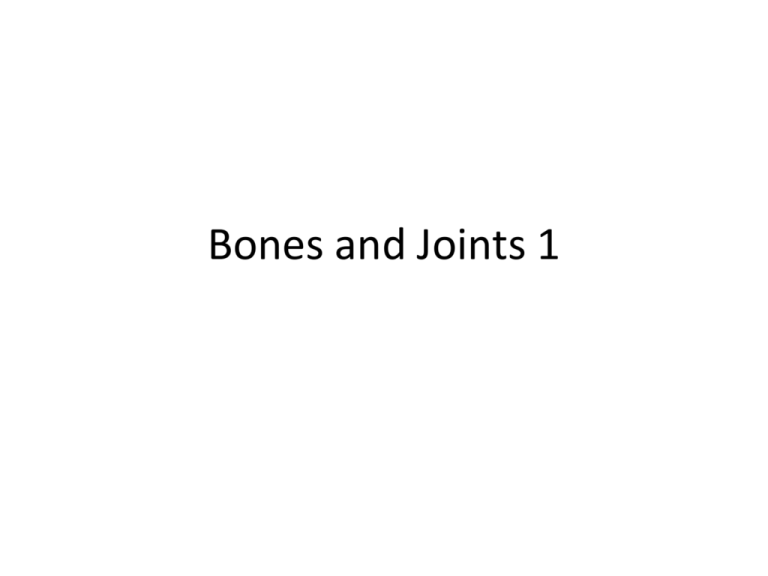
Bones and Joints 1 The Skeletal System • Bone is a 4ssue, a living material made up of cells, and is it full of capillaries. • The skeletal system is made up of bones which are connected to each other by joints. • Almost all bones have at least one joint. Muscles are fibres that have the ability to contract so that we can move our bodies and internal organs. • All these elements make up the musculoskeletal system whose func4on it is to allow us to perform movement. Egg Shell vs. Bone Egg shell composi:on Bone composi:on Mostly made of calcium carbonate (CaCO3) Collagen Protein Calcium carbonate Calcium phosphate 4 types of bones based on shape Type of bone Example in body Main Func4on in body Long Bones Femur, humerus. work with muscles to move body parts, storage, support, blood produc4on. Short bones Tarsals, carpals, clavicle work with muscles to move body parts, storage Flat bones Sternum, cranium, scapula Irregular Bones The vertebrae, mandible, Iliac. Protect organs, blood produc4on Support, blood produc4on, movement General Structure of the Human Body A. 3 Anatomical regions of the body: Head Trunk Limbs λ λ λ 15 16 17 18 19 Bone shape 1. Humerus long 2.Radius Long 3.Ulna Long 4.Femur Long 5.Fibula Long 6.Tibia Long 7.Cranium Flat 8. Mandible Irregular 9. Clavicle Short 10.Scapula Flat 12. Rib cage 13. Vertebrae 14. Iliac bone (Pelvis) Long Irregular Irregular with flat regions 15.Carpals Short 16.Phalanges short 17.Patella Short 18.Tarsals Short 19.Phalanges of the foot short • How many bones are there in the human skeleton? • How many bones in a newborn’s skeleton? • Why the difference? • How many bones are there in the human skeleton? 206 • How many bones in a newborn’s skeleton? 270 • Why the difference? During development, your bones fuse together Give examples of bones that fuse during development. • hcp://www.pennmedicine.org/encyclopedia/ em_DisplayAnima4on.aspx? gcid=000112&p4d=17 Where are your organs in rela4on to your skeletal system? The Skeletal System Func4on forms an internal, living framework that - provides shape and support protects internal organs moves body forms blood cells stores calcium and phosphorous compounds for later use λ λ λ λ λ Joints • Defini4on: Any place where two or more bones come together - Joints • Kept far enough apart by a thin layer of car4lage so that they do not rub against each other as they move When this happens it can cause swelling at the joint and create symptoms of arthri4s. - • Bones are held in place at joints by a tough band of 4ssue called ligament Types of Joints • Fixed Skull Pelvis - - • Semi-­‐movable Vertebral column - • Moveable Pivot Ball & socket Hinge Gliding - - - - Types of Joints • Ball and Socket Joint Bone with a rounded end that fits into a cuplike cavity on another bone à ex: shoulder joint: scapula to humerus λ hcp://www.shockfamily.net/skeleton/JOINTS.HTML Types of Joints • Pivot Joint One bone rotates in a ring of another bone that does not move à ex: radius and ulna à ex: neck joint λ hcp://www.funhousefilms.com/b-­‐pivot2.jpg Types of Joints • Hinge Joint Back-­‐and-­‐forth movement like hinges on a door à ex: elbow joint (humerus into radius) λ hcp://www.shockfamily.net/skeleton/JOINTS.HTML Type of Joints • Gliding Joint One part of a bone slides over another bone à ex: carpals into metacarpals λ hcp://www.shockfamily.net/skeleton/JOINTS.HTML Video-­‐ joints • hcp://www.youtube.com/watch? v=ecRoUeL5k6E • hcp://www.youtube.com/watch? v=sW3-­‐9zM9ohE




